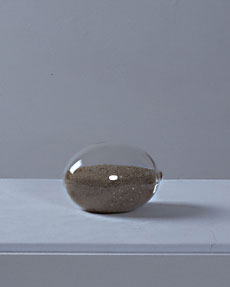|
Jochem Hendricks (born
1959) draws not with his hand, but with his eyes. Using apparatus constructed
specifically for this purpose, consisting of a helmet, infra-red rays,
video cameras and a computer, his eyes produce illustrations of what they
are observing or reading at the time—be it a newspaper, a cup or
a nude photo. The process is a metaphor: the eye records the external
world in a practical, everyday way and creates an illustration of it in
the brain. But in fact the eye is not a passive but a very active, productive
organ. The conventional theory of the eye being passive is based on a
notion of an analytical division between brain’s activity and eye.
Since Kant, we have been aware that the external world as such is not
accessible to us but is just subjective; in other words thinking and seeing
are closely related, as are speaking and thinking, through the active
mediation of our perception. By contrast, the hand that draws is only
a performing body part and its activity—compared with seeing—is
only a secondary one. Hendricks’s process frees itself from the traditional
technique of drawing, depending as it does on the state of the soul, skill
and chance. Freed from the often wilful, expressive movement of the hand,
the artist wishes to achieve as much objectivity as possible. The creation
of art is no longer a mystery. The originality lies in the concept and
no longer in the execution. The grains of sand are another strange work.
Together with 12 assistants, Heindricks counted 3,281,579 grains of sand.
This took approximately 1,000 hours. The hand-picked grains are exhibited
in an egg-shaped glass holder. On the outside the sand grains cannot be
told apart. The grains of stand represent the arduous task work only in
as much as you know that the pile of sand is a product of counting. And
due to the fact that you know that it took about 1,000 hours to count
them, the grains also represent the hours of labor. Now they are considered
not so much as dirt, but as the result of great effort. There cannot be
many more senseless tasks than counting grains of sand. After all, a small
pile of sand is neither a useful nor an attractive product. Such a senseless
task of counting becomes meaningful only by the fact that it presents
itself—by way of the sand pile—as art. «Eye drawings»
and «Grains of Sand» get round the criterion of inter-subjectivity
in natural science, by which a scientific work is considered objective
only if it can be reproduced under another set of identical conditions:
anybody could produce eye drawings using Hendricks’ process and anybody
could count the grains of sand again if he has any doubts that there really
are 3,281, 579 grains. The versatile concept artist recently caused a
stir with a tower made of objects he had stolen himself.
Burkhard Brunn
|
